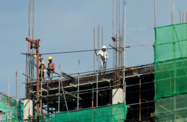A projected housing shortage in Myanmar is driving the construction of affordable units in Yangon, with the government looking to assist development through new partnerships, project funding, legislative change and mortgage market support.

In August the Myanmar Construction Entrepreneurs Association signed a memorandum of understanding with Singaporean engineering consulting agency Surbana Jurong to help develop a prototype for affordable housing design.
Under the agreement, Surbana Jurong will provide the association with technology, design advice and engineering solutions that minimise construction time while maintaining safety and functionality of low-cost apartments.
Also in August, Myanmar’s Department of Urban and Housing Development announced plans to build 180,000 residential units in Yangon by 2040 to help meet expected demand for affordable housing.
At around 8000 units per year, this represents 20% of the projected long-term demand in the commercial capital, with the remaining 80% to be provided by the private sector and by local and regional governments, according to U Nway Hmu, deputy director of the Department of Urban and Housing Development.
The Ministry of Construction estimates that Myanmar will need 4.8m more housing units by 2040 – 1m in Yangon alone – as the country’s population is projected to swell from 51.5m in 2014 to 70.6m in 2040.
Government funding supports affordable housing development
To help fill this gap, the central government has allocated some MMK46bn ($33.8m) for FY 2016/17 to build low-cost housing, including MMK20bn ($14.7m) allocated to the Mahabandoola rental housing project.
Managed by the Yangon regional government and being built by around 20 contractors, the Mahabandoola initiative will supply 1200 apartments measuring 55 sq metres, with rent set at MMK30,000 ($22) per month.
Due to high demand for such apartments, only individuals who do not already own property will be eligible for tenancy, and from there candidates for flats will be chosen by public lottery. The Yangon regional government says it has received more than 35,000 applications for the 1200 units.
Sales of 991 more Mahabandoola units opened this month in the townships of Dagon Seikan and Hlaing Thar Yar, with prices ranging from MMK9m ($6600) for top-floor units to MMK12m ($8800) for ground-floor units, U Nway Hmu told media in August.
The state is also supporting uptake through subsidised mortgage loans supplied by the Construction and Housing Development Bank – a quasi-government institution founded in 2013 for this purpose.
Potential buyers must have a monthly income of at least MMK500,000 ($370) and – if chosen by public lottery – will have access to loans worth up to 70% of property value, which buyers must pay back over 10 years at a rate of 13% interest.
Legislative changes aimed at attracting foreign investment
The government’s commitment to solving the housing shortage is also evident in recent legislation. The Myanmar Investment Law – passed by Parliament in October 2016 and approved by the Cabinet soon after – identified the construction of affordable housing as being among 10 priority areas in which foreigners are permitted to invest, with the Ministry of Planning and Finance issuing implementation rules for the law in March.
An earlier bill with a similar goal was the Condominium Law approved by Parliament and made effective as of January 2016. The legislation has allowed foreign ownership of property – limited to 40% of the floor space of a given condominium – for the first time. However, as no housing projects have yet been registered under this law, it has not been seen in practice.
One obstacle to encouraging overseas investment in the current environment is the fact that prices in the mid- and high-end markets – where investment returns are greatest – have fallen considerably from the all-time highs seen in 2013. According to Colliers data, prices dropped by 41% for mid-tier condominiums and by 22% for luxury units over the 2014-16 period.


